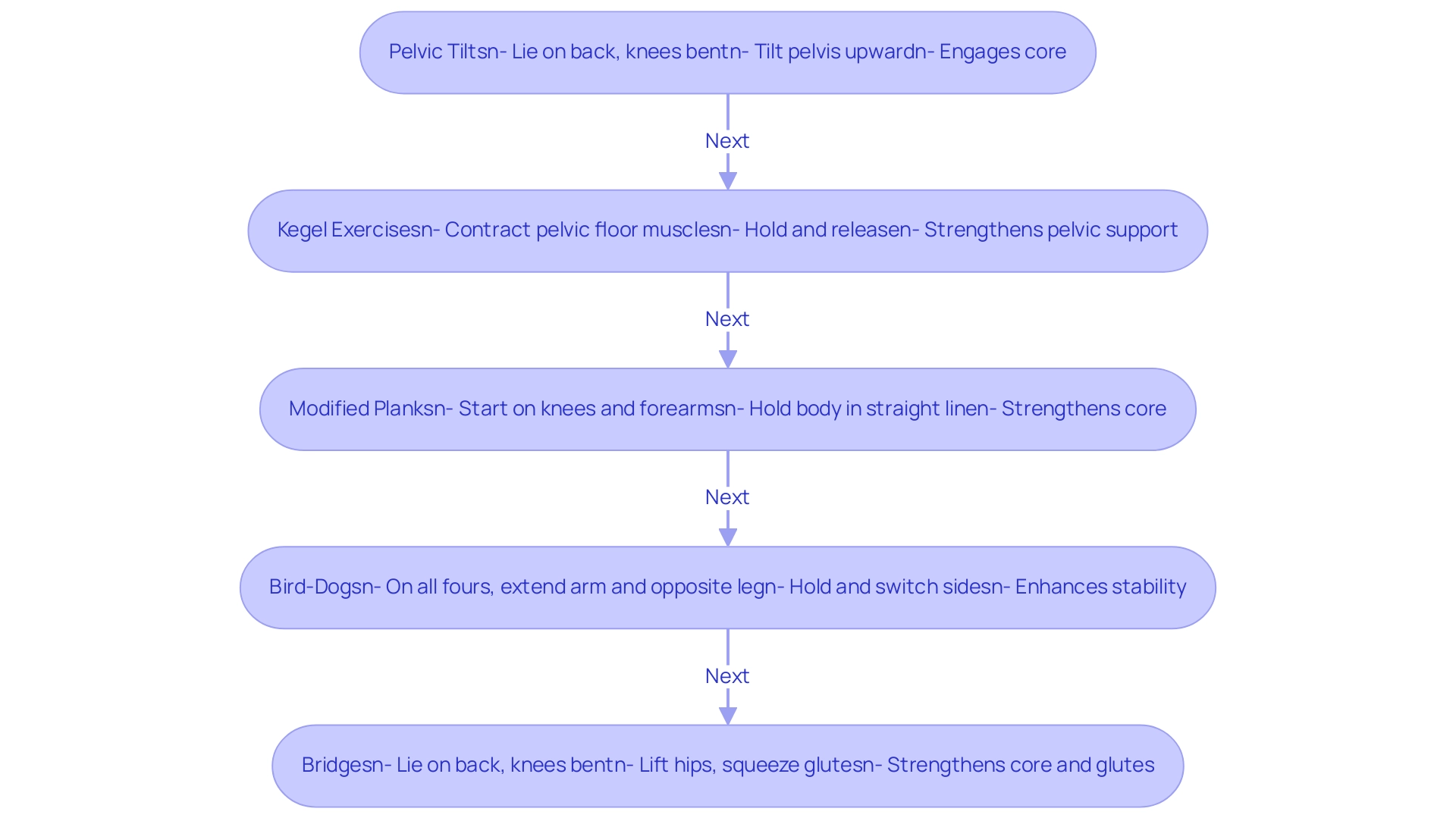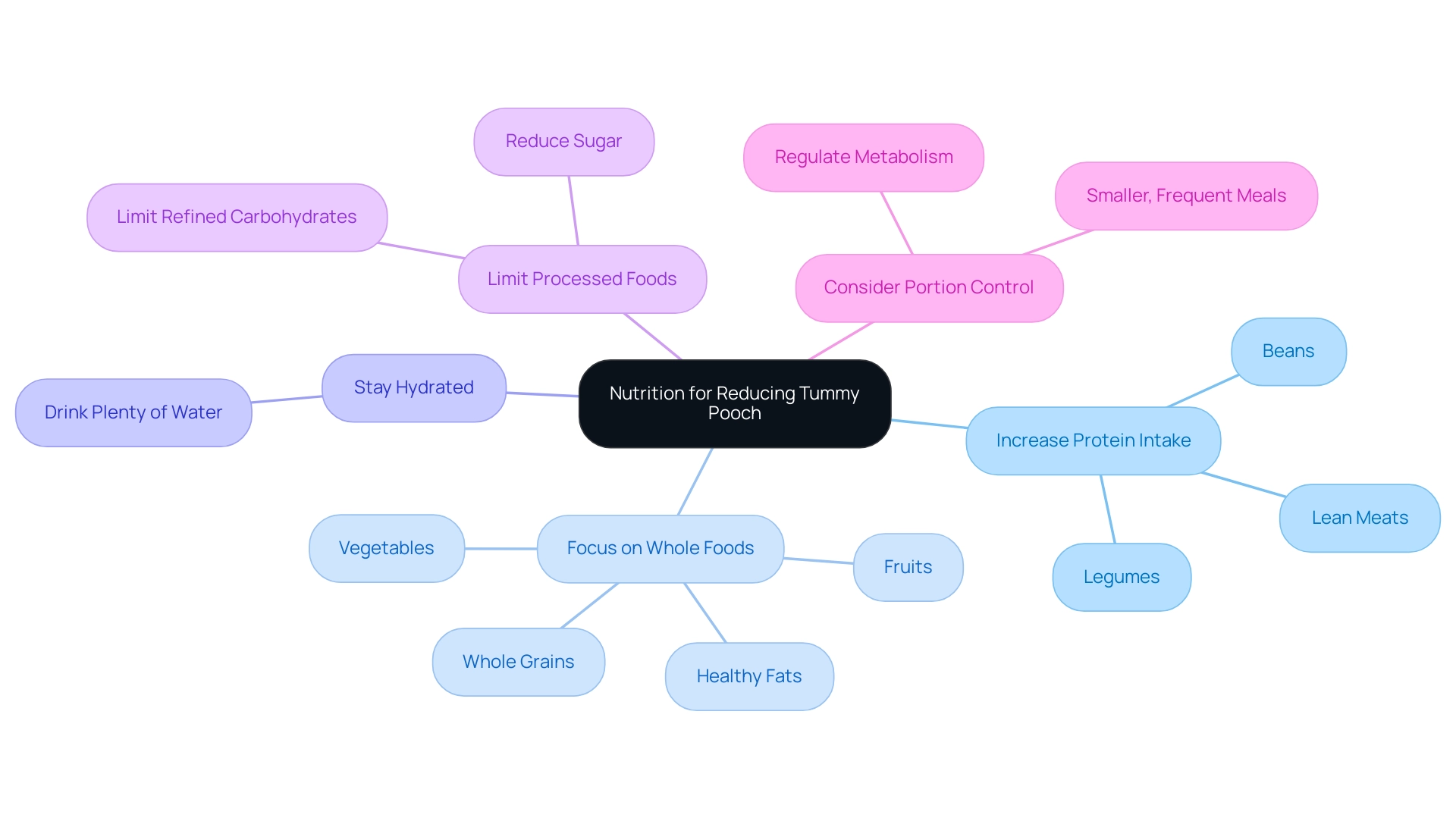Overview
The article focuses on effective exercises for reducing tummy pooch, particularly for new mothers, and emphasizes the importance of combining physical activity with nutritional strategies for optimal results. By outlining specific exercises like pelvic tilts and Kegel exercises, along with dietary recommendations, the article highlights how these approaches can enhance recovery, improve core strength, and foster a positive body image following childbirth.
Introduction
The journey of motherhood is a profound transformation, both physically and emotionally. For many women, the experience comes with the challenge of the so-called "mom pooch," a common concern that can impact self-esteem and overall well-being after childbirth. Understanding the factors contributing to this condition—ranging from hormonal changes to the stretching of abdominal muscles—can empower women to embrace their bodies during this transitional phase.
Beyond the physical appearance, the implications of a tummy pooch can deeply affect emotional health, often leading to feelings of inadequacy in a society that frequently pressures women to conform to unrealistic body standards. However, by fostering a supportive environment and encouraging healthy practices—both in exercise and nutrition—HR Benefits Managers can play a pivotal role in promoting the well-being of new mothers.
This article delves into effective strategies for addressing tummy pooch, highlighting the importance of community support, holistic health, and self-acceptance in the postpartum journey.
Understanding the Mom Pooch: Causes and Implications
The phrase 'mom pooch' refers to the protruding belly that many individuals experience after childbirth, a condition affected by various factors such as hormonal changes, gain in mass, and the stretching of abdominal muscles during pregnancy. Joao Paulo Souza, Center Director of the Latin American and Caribbean Center on Health Sciences Information, emphasizes the importance of addressing maternal health by stating,
Maternal health is not just something that we should start worrying about when the pregnancy bump appears.
Identifying these causes is crucial, as it reassures individuals that they are not alone in navigating this journey.
Beyond physical appearance, the implications of a tummy pooch can deeply affect emotional well-being, often leading to discomfort and self-consciousness. The pressures to 'get your body back' can be harmful and unrealistic, amplifying feelings of inadequacy among new mothers. A case study titled 'Long-term Implications of Excess Weight' highlights that carrying excess weight into subsequent pregnancies can lead to poorer outcomes, such as gestational diabetes and lower breastfeeding rates, underscoring the importance of addressing postpartum body image.
Statistics indicate that a substantial proportion of females begin pregnancy overweight or obese, which raises concerns for maternal health. Understanding that the prevalence of mom pooch is a shared experience can motivate women to embrace their health and fitness goals, including incorporating exercises for tummy pooch, fostering a supportive environment that encourages positive body image and self-acceptance. Recent studies also indicate that societal pressures regarding postpartum body image can exacerbate emotional struggles, making it vital to create awareness and support for new mothers.

Effective Exercises to Combat Tummy Pooch
To effectively tackle tummy pooch, consider incorporating the following activities into your routine:
-
Pelvic Tilts: Begin by lying on your back with your knees bent. Flatten your back against the floor by tilting your pelvis upward, holding this position for a few seconds before releasing. This simple movement promotes core engagement and stability.
-
Kegel Exercises: These are crucial for strengthening pelvic floor muscles. Contract the muscles you would use to stop urination, hold for several seconds, and then release. Regular practice can enhance pelvic support and improve recovery.
-
Modified Planks: Starting on your knees and forearms, align your body in a straight line from head to knees. Aim to hold this position for 20-30 seconds, gradually increasing your duration as your strength builds. This activity not only strengthens the core but also boosts overall body awareness.
-
Bird-Dogs: Position yourself on all fours, extending one arm forward while simultaneously extending the opposite leg back. Hold for a moment before switching sides. This dynamic movement engages the core and enhances stability, fostering balance in everyday activities.
-
Bridges: Lie on your back with your knees bent and feet flat on the floor. Lift your hips towards the ceiling, squeezing your glutes at the top, then lower back down slowly. Bridges are outstanding for enhancing both the core and gluteal muscles.
Incorporating exercises for tummy pooch into their routines can assist individuals in effectively fortifying their core, leading to a flatter stomach over time. Research indicates that adherence to such physical activity regimens can significantly enhance recovery outcomes after childbirth, with studies showing that consistent movement can lead to better body composition management. Moreover, a recent case study on online fitness interventions for mothers highlighted both strengths, such as participant randomization and virtual delivery, and limitations like a small sample size.
This contributes valuable preliminary evidence regarding the efficacy of these interventions. Success stories from women who have utilized pelvic tilts and Kegel techniques reflect the positive impact these practices can have on their physical wellness and confidence. As HR Benefits Managers, promoting these exercises not only aids in individual health but also fosters a supportive environment for recovery after childbirth within your teams.

The Role of Nutrition in Reducing Tummy Pooch
To effectively combat tummy pooch, embracing the following nutritional guidelines is essential:
- Increase Protein Intake: Emphasizing protein is crucial, as it plays a vital role in muscle repair and growth. Incorporate lean meats, beans, and legumes into your meals to support recovery and strength.
- Focus on Whole Foods: Prioritize the consumption of fruits, vegetables, whole grains, and healthy fats. These nutrient-dense foods not only provide essential vitamins and minerals but also aid in maintaining a healthy weight, helping to alleviate abdominal concerns.
- Stay Hydrated: Adequate hydration is key for reducing bloating and enhancing digestion. Encourage your team to drink plenty of water throughout the day to support their overall health.
- Limit Processed Foods: Reducing sugar and refined carbohydrates can significantly impact fat accumulation around the abdomen. Encouraging a diet low in processed items can help foster better health outcomes.
- Consider Portion Control: Eating smaller, more frequent meals can help regulate metabolism and prevent overeating. This approach can be especially advantageous during the period following childbirth when maintaining energy levels is vital.
Incorporating these nutritional strategies is especially important as randomized controlled trials have shown that lifestyle modifications can reduce the incidence of type 2 diabetes by up to 58% for people at high risk. Additionally, encouraging friends and family to bring healthy meals during the early weeks after childbirth can provide essential support for new mothers.
A community-based cross-sectional survey conducted in the Shey-Bench District of southwest Ethiopia highlighted the significance of dietary diversity among mothers after giving birth, revealing a lower prevalence of underweight compared to overweight. This highlights the necessity for nutrition education and cooperation across sectors to support health after childbirth.
By merging these nutritional strategies with regular exercise, individuals can effectively improve their efforts by incorporating exercises for tummy pooch and promote overall well-being.

Diastasis Recti: Understanding Its Impact on Tummy Pooch
Diastasis recti, characterized by the separation of abdominal muscles during pregnancy, can lead to a noticeable gap that makes exercises for tummy pooch particularly beneficial. This condition is especially relevant for those in the postpartum period, as it not only influences physical appearance but also has profound implications for core stability and strength. A recent study revealed that 94.3% of first-time mothers reported awareness of diastasis recti, yet many expressed concerns about their abdominal appearance and perceived muscle weakness.
While the study concluded that there were no differences in the occurrence of urinary incontinence (UI) and pelvic organ prolapse (POP) between individuals with and without DRA, it highlights the need for further research on DRA's influence on abdominal strength and lumbopelvic pain. KB, who planned the study and contributed significantly to the manuscript, emphasizes the importance of understanding this condition. If you suspect you have diastasis recti, seeking guidance from a healthcare professional or physical therapist is crucial.
These specialists can carry out a comprehensive evaluation and suggest tailored routines that incorporate exercises for tummy pooch, designed to safely strengthen your abdominal muscles and assist in closing the gap. Understanding diastasis recti empowers women to take proactive steps toward healing and reclaiming their core strength, ultimately fostering confidence in their postpartum recovery journey. Remember, addressing this condition is not just about aesthetics; it's about restoring your body’s functionality and well-being.

Holistic Strategies for a Flatter Stomach
To achieve a flatter stomach through holistic strategies, consider incorporating exercises for tummy pooch along with a balanced routine that includes cardiovascular workouts, strength training, and flexibility exercises. This combination not only enhances fitness but also increases metabolism, crucial for managing body composition.
- Mindfulness and Stress Management: Engage in practices such as yoga or meditation to effectively manage stress levels. High stress can lead to an increase in mass and bloating, so cultivating mindfulness is crucial for overall health. According to wellness expert Dana Vioreanu, by leveraging customization, these offerings not only support individuals in achieving healthier body compositions but also help mitigate the long-term health and economic burdens associated with obesity.
- Cultural Considerations: In Asia, cultural perceptions of beauty and traditional medicine play a significant role in managing body size. Many women may prefer holistic approaches, such as herbal supplements and natural remedies, which align with these cultural values.
- Prioritize Sleep: Ensure adequate sleep as it significantly impacts metabolism and recovery. Studies indicate that insufficient sleep can disrupt hormonal balance, making control of body mass more challenging.
- Stay Active Throughout the Day: Integrate movement into your daily life by taking brief walks or participating in active hobbies. This constant flow of activity contributes to overall energy expenditure and helps maintain a healthy weight.
- Set Realistic Goals: Focus on gradual improvements rather than seeking immediate results. This sustainable approach not only promotes a healthier mindset but also supports long-term commitment to wellness practices.
- Understanding Research Limitations: It's important to note that many studies evaluating management strategies have a moderate risk of bias. The lack of standardized methodologies in weight loss research, as highlighted in recent case studies, can hinder the effectiveness of holistic approaches, such as exercises for tummy pooch, which enable women to work towards a flatter stomach while simultaneously enhancing their overall well-being and quality of life. The journey towards health is not just about physical appearance; it's about nurturing a balanced lifestyle that promotes happiness and vitality.

Conclusion
The journey to understanding and addressing the "mom pooch" is one that encompasses both physical and emotional dimensions. By recognizing the causes behind this common postpartum concern—such as hormonal changes, muscle stretching, and societal pressures—women can begin to embrace their bodies with compassion and self-acceptance. The importance of fostering a supportive environment cannot be understated, as it plays a crucial role in helping new mothers navigate the challenges they face.
Implementing effective strategies, including targeted exercises and nutritional guidance, can empower women on their path to recovery and wellness. Simple practices such as:
- Pelvic tilts
- Kegel exercises
- A focus on whole foods
can make a significant difference in not only physical appearance but also in overall emotional health. Additionally, understanding conditions like diastasis recti provides women with the knowledge needed to seek appropriate help and take proactive steps towards regaining core strength.
Ultimately, creating a culture that prioritizes holistic health and realistic goals will benefit not only individual mothers but also their families and communities. By championing these practices, HR Benefits Managers can lead the charge in promoting well-being and self-acceptance among new mothers, reinforcing the message that recovery is a journey worth supporting. Embracing this initiative could foster a healthier, happier environment where every woman feels valued and empowered in her postpartum experience.




